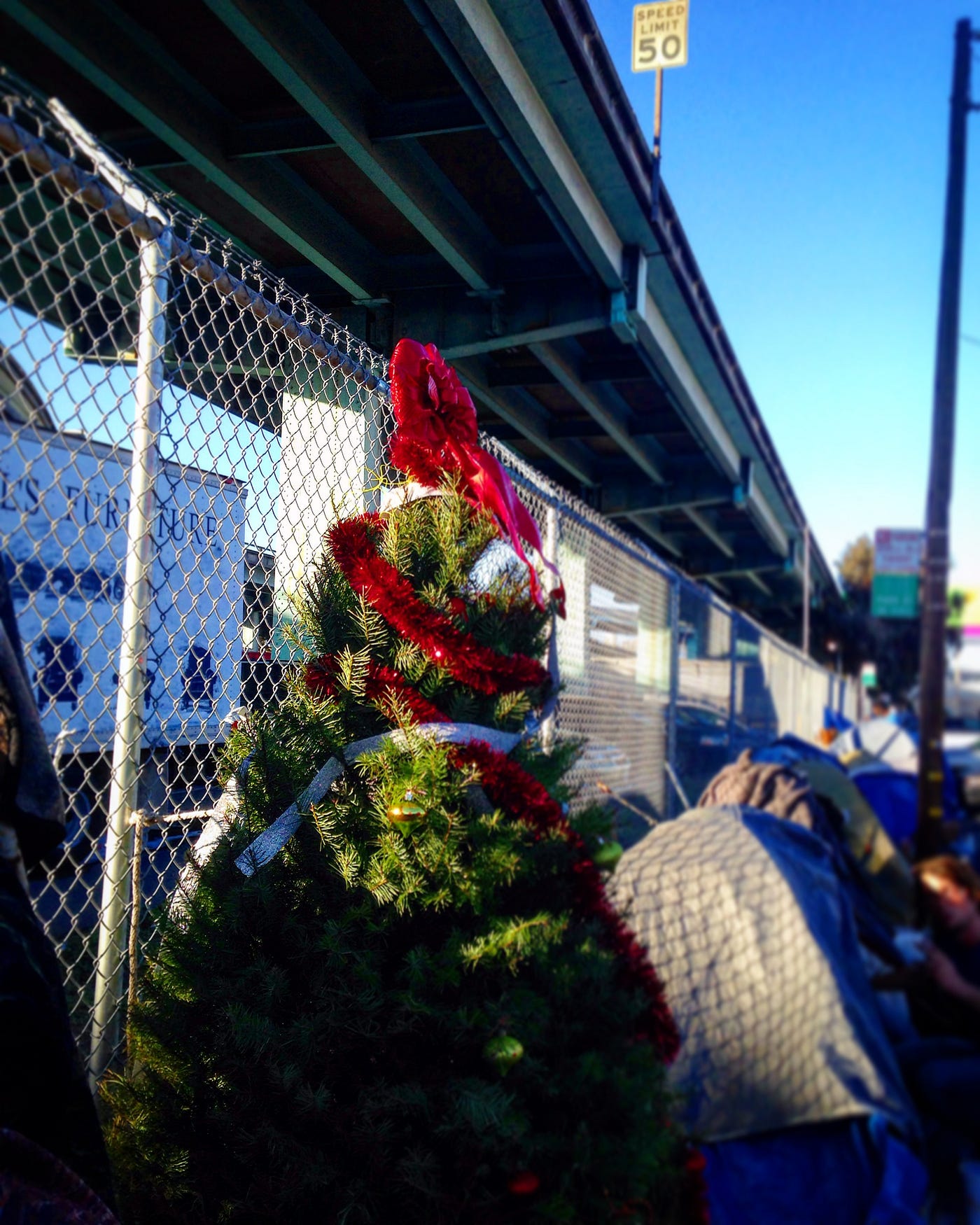
“This will be my third Hanukkah I’ll be celebrating on the streets,” says Judith Cherner, one of the estimated 9,784 (or more) homeless people on the streets of San Francisco. Like many others in similar situations, the 42-year-old’s life was fine — until it wasn’t. She lost her job; she wasn’t able to receive treatment for her mental health issues; she emptied out her savings account — all factors contributing to her inability to return to permanent housing.
Cherner’s tidy two-person tent is perched near Nob Hill; in the back, there’s a candle-free menorah. To celebrate the holidays, she usually visits nonprofits in the area that offer resources and some holiday cheer.
“I’ve visited Jewish Family and Children’s Services for food and have never been turned down,” says Cherner, her voice warm as she speaks of these low-key holiday rituals. “GLIDE has been kind to me too. Most synagogues are a walk for me, but I will try my best to go during Hanukkah.”

More than 60% of Americans report feeling more “stressed or anxious” during what’s meant to be the most wonderful time of the year. For the homeless, that feeling is amplified.
This time of year is also one when people are most interested in helping others. Often, volunteer shifts fill up more quickly than during other months, but there’s still plenty you can do to make a difference in a homeless person’s life over the holidays.
“If you want to be really radical and helpful, gift someone a tent and sleeping bag.”
Donating food and other essentials — tampons, toothpaste, and other toiletries—is always welcome and a good place to start.
“Things like socks, blankets, pads— items along those lines never lose their value,” says Kelley Cutler, the human-rights organizer for the Coalition on Homelessness. “Hell, if you want to be really radical and helpful, gift someone a tent and sleeping bag. From sleeping on the street to having a tent to zip up [to get] some privacy can be a life-changing shift.”
And while Cutler says that while food at this time of year is plentiful at facilities and resources for the homeless, that shouldn’t dissuade you from offering meals to the people you come across. She suggests that you bring clean metal or high-quality-plastic utensils, as well as storage containers that people can use after they finish their meals. Avoid single-use plastic forks, spoons, and Styrofoam plates — because…Mother Nature.
Clearly, having a warm and safe place to sleep is what is most important to homeless people. Unfortunately, with only 1,023 shelter beds available in the city, there’s still a shortage of at least 7,000-plus beds. It’s not uncommon to hear of people being put on two-month-long wait lists for a 90-day shelter stay.
On the bright side, San Francisco is expected to offer some 100 extra beds as part of the Interfaith Winter Shelter Program from Episcopal Community Services and the San Francisco Interfaith Council. The twist? Only men can access them.
Privately owned service providers are also attending to the thousands of homeless — of all genders — in the city. Raphael House of San Francisco is one, offering a 31-room family shelter with programs and activities throughout the holidays. Those with the means to be financially generous can adopt a family through the organization; it’s estimated that 1,100 of California’s estimated 20,000 homeless youth are in San Francisco.
“We welcome as many as we can to enjoy a warm private room and meals every day,” said Esteban Cortez, marketing communications manager for Raphael House. “We do host a Santa gift drop-off closer to Christmas. Plus, we host family-activity nights every week, and we set the themes around the holidays.”
Other ways to help: the Homeless Children’s Network is actively taking gifts to distribute to the children it serves, while St. Anthony’s will gladly take everything from nonperishables to new or used cars. When in doubt, don’t forget that online donations to local, small-scale nonprofits are always welcome.
Cortez says that another gift that helps is some type of financial cushion.
“What people sometimes forget about is that the greatest gift of all is access to more opportunities, like gift cards to clothing stores, grocery stores, and more,” Cortez said, also noting that Uber and Lyft ride credits are useful. “We help our clients take advantage of them, using [these services] to get to and from grocery runs, haircuts, other means of self-care, doctor appointments, job interviews — you name it.”
“Think about volunteering on a random weekday or weekend a few times a month rather than just on the big holidays, because most organizations are inundated with support around Thanksgiving and Christmas… and it’s harder to volunteer due to the paperwork and other hurdles.”
If your resources don’t extend to offering gifts like this, you can always volunteer — though both Cutler and Cortez recommend that you volunteer year-round, not just during the holidays when it’s popular to do so. “Homeless people don’t stop existing just because the holidays are over,” Cutler says.
“You see encampments put up Christmas trees and decorate them with creative uses of the stuff around them. Everyone in the community gets involved.”
But there’s also something each of us can do that doesn’t cost anything.
“One of the best ways you can be there for the homeless during the holidays — or any time of year — is to just talk to them and asked them what they need,” says Cutler. “Try to just hold space for someone on the streets this year — try it. Just talk to them and say ‘Hi, how are you?’ You could be the only person they’ve talked to all day or that week.”
As Cutler added, “You see encampments put up Christmas trees and decorate them with creative uses of the stuff around them. Everyone in the community gets involved. When you’re stripped of everything, you realize that what truly matters in our lives are our relationships.”




